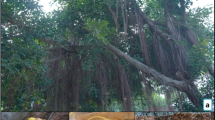Abstract
Fibrous plants are available in abundance in nature and are a renewable resource. The development of high performance composites from a cheap natural fiber, such as water hyacinth (Eichhornea crassipes) is particularly beneficial from an economic point of view. Remarkable, thermosetting resins such as polyester are used widely as a composite matrix due to polyester resins present a good dimensional stability, thermal stability, and good mechanical properties. For this study, some composites from water hyacinth fiber and polyester resin were prepared by using solution impregnation and hot curing methods. The composites were prepared by varying fiber percentages (5, 10, 15, and 20 wt%). These were characterized by FTIR and DSC analysis. Additionally, the elastic modules (MOE) from static test according to ASTM (D143-94) and by dynamic test from Sylvates Duo were obtained. Mechanical properties such as flexural strain and compression strength parallel of the different composites were analyzed. Thus, composites which had a concentration of water hyacinth in the range of 5 to 10 wt% yielded the best results. Additionally, the analysis showed no evidence of a negative effect on mechanical and thermal properties of the composite by addition of water hyacinth to the polyester resin. Furthermore, the results showed that water hyacinths fibres presented a competitive reinforcement quality when they were compared with other natural fibers, as such jute, abaca, and rice straw.
Similar content being viewed by others
References
K. K. Chawla and J. R. M. D’Almeida, “Proc. of ICCM-IV IVth Int. Conf. Composite Materials”, p.1195, Tokyo, Japan, 1982.
K. G. Satyanarayana, K. Sukumaran, A. G. Kulkarni, S. G. K. Pillai, and P. K. Rohatgi, Composites, 17, 329 (1986).
T. Rials, M. P. Wolcott, and J. M. Nassar, J. Appl. Polym. Sci., 80, 546 (2001).
J. R. M. D’Almeida, Polymer Plast. Tech. Eng., 40, 205 (2000).
Q. Mahmood, M. R. Siddiqi, E. Islam, M. R. Azim, P. Zheng, and Y. Hayat, J. Zhejiang Univ. Sci. B. 10, 991 (2005).
M. Meerhoff, N. Mazzeo, B. Moss, and L. Rodríguez-Gallego, Aquat Ecol., 37, 377 (2003).
P. Pranut, P. Prakaipech, and C. Saowaroj, J. Sci. Res. Chula. Univ., 26, 1 (2001).
O. Mansour, B. Abdel-Hady, S. K. Ibrahem, and M. Goda, Polymer Plast. Tech. Eng., 40, 311 (2001).
H. U. Zaman, M. A. Khan, R. A. Khan, M. A. Rahman, L. R. Das, and M. Al-Mamun, Fiber. Polym., 11, 455 (2010).
A. K. Rana, A. Mandal, and S. Bandyopadhyay, Compos. Sci. Technol., 63, 801 (2003).
ASTM D143-14, Standard Test Methods for Small Clear Specimens of Timber, ASTM International, West Conshohocken, PA, 2014.
D. H. Williams and I. Fleming, “Spectroscopy Methods in Organic Chemistry”, 5th ed., pp.35–42, McGraw Hill, Maidenhead, England, 1995.
G. A. L. Verleye, N. P. G. Roeges, and M. O. De Moor, “Easy Identification of Plastic and Rubbers”, pp.115–134, Rapra Technology Ltd., Shrewsbury, UK, 2001.
U. Knuutinnen and P. Kyllonen, e-Preserv. Sci., 3, 11 (2006).
N. Shukry and B. S. Girgis, Polymer Plast. Tech. Eng., 31, 541 (1992).
M. R. Huang and X. G. Li, J. Appl. Polym. Sci., 68, 293 (1998).
S. Montserrat, C. Flaque, P. Pages, and J. Maek, J. Appl. Polym. Sci., 56, 1413 (1995).
M. I. Aranguren, N. E. Marcovich, and M. M. Reboredo, Mol. Cryst. Liquid Cryst., 353, 95 (2000).
A. Rohanová, R. Lagaňa, and V. Vacek, Annals of Warsaw University of Life Sciences-SGGW For. and Wood Technol., 72, 229 (2010).
H. Toker, E. Baysal, A. Özçifçi, M. Altinok, A. Sönmez, F. Yapici, and S. Altun, Wood Res., 53, 59 (2008).
Author information
Authors and Affiliations
Corresponding author
Rights and permissions
About this article
Cite this article
Flores Ramirez, N., Sanchez Hernandez, Y., Cruz de Leon, J. et al. Composites from water hyacinth (Eichhornea crassipe) and polyester resin. Fibers Polym 16, 196–200 (2015). https://doi.org/10.1007/s12221-015-0196-5
Received:
Revised:
Accepted:
Published:
Issue Date:
DOI: https://doi.org/10.1007/s12221-015-0196-5




